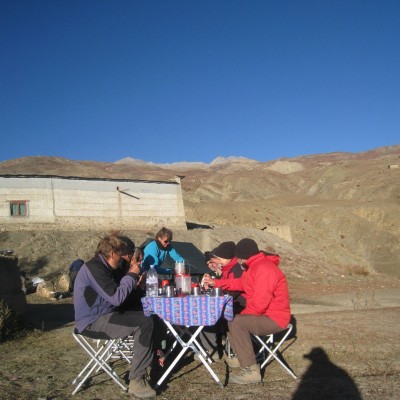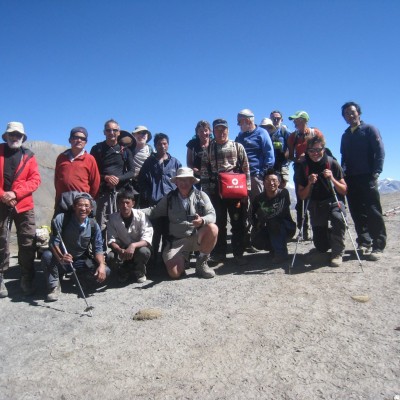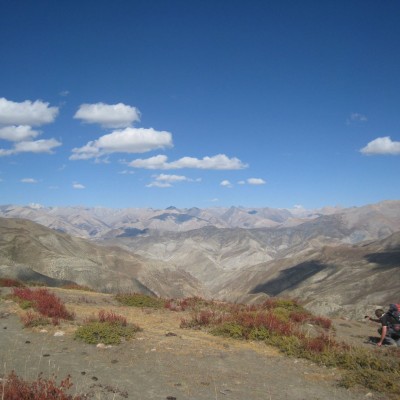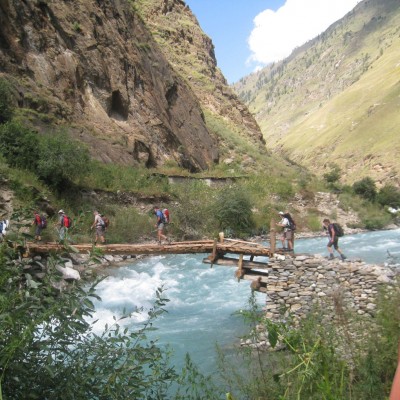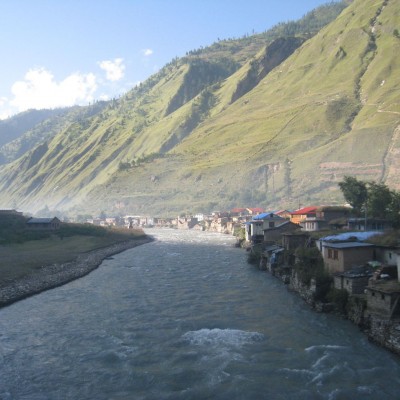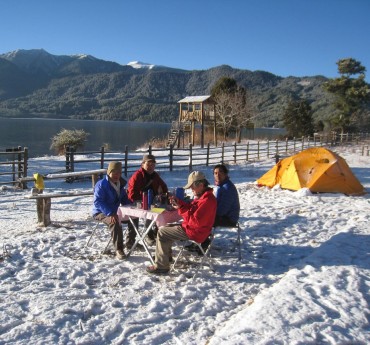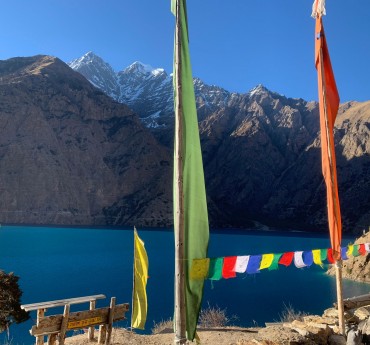The Upper Dolpo trek is among Nepal's most challenging and rewarding adventures, designed for exceptionally fit and adventurous trekkers. This remote and rugged region, located on the isolated fringes of the Tibetan Plateau, offers a rare glimpse into a traditional way of life preserved for centuries. Trekkers will navigate through high-altitude terrain with camps situated above 4,500 meters and multiple passes exceeding 5,000 meters. The region's inhabitants, descendants of Tibetan nomads, continue to uphold 2,500-year-old rituals rooted in both Tibetan Buddhism and the pre-Buddhist Bon Po religion.
The remoteness of Dolpo has shielded its people from modern influences, leaving their traditions and lifestyle largely unchanged. Until the mid-20th century, the outside world was scarcely aware of this hidden land. It was brought to international attention by Peter Matthiessen’s The Snow Leopard and David Snellgrove’s Himalayan Pilgrimage. Even so, Upper Dolpo remained off-limits to trekkers until 1989. Further intrigue grew after the release of the 1999 Oscar-nominated film Himalaya, which beautifully captured the region’s mystical landscapes and unique culture.
As the least-developed district in Nepal, Upper Dolpo lacks basic tourism infrastructure, making this a fully self-supported camping trek. Trekkers can trust Himalayan Paradise to provide ample supplies, including food, ensuring a safe and comfortable journey despite the region’s occasional food shortages. For those seeking a true escape into an unspoiled world, Upper Dolpo offers a once-in-a-lifetime experience of natural beauty, cultural richness, and profound solitude.
Highlights
Upper Dolpo: A Hidden Jewel of Natural and Cultural richness.
Nestled in the remote northwestern region of Nepal, Dolpo is a land of awe-inspiring landscapes and rich cultural heritage. This extraordinary region is home to the pristine Phoksundo Lake, towering Himalayan passes, fortified villages (dzongs), and ancient monasteries (gompas) such as the 800-year-old Shey Gompa and the enigmatic Crystal Mountain, revered by pilgrims for its spiritual significance.
Shey Phoksundo National Park: A Sanctuary for Wildlife
Dolpo lies within Shey Phoksundo National Park, Nepal’s largest national park, which serves as a haven for rare wildlife. The park shelters species such as blue sheep, elusive snow leopards, marmots, and Himalayan hares. Hunting and poaching are strictly prohibited, preserving the park's biodiversity and ecological balance.
Getting There: A Journey in Itself
Accessing Dolpo is an adventure. Travelers first take a flight to Nepalgunj, a tropical city near the Indian border. From Nepalgunj, a connecting flight takes you to Juphal, the only airstrip in Dolpo. The trek concludes with a return flight from Jomsom, located in Mustang, to Pokhara.
The Trail: A Journey through Lower and Upper Dolpo
Dolpo is divided into Lower Dolpo, characterized by semi-arid terrain and vibrant springtime blooms, and Upper Dolpo, a rugged, arid landscape nestled behind the Annapurna, Dhaulagiri, and Kanjirowa Himalayan ranges.
Highlights of the Trek
Phoksundo Lake (3,608m): After three days of hiking along the Phoksundo River, trekkers reach this turquoise jewel, Nepal’s largest lake, surrounded by snow-capped peaks. Measuring 4.8 km in length, 1.8 km in width, and 650 meters in depth, it offers unparalleled serenity.
Kang-La Pass (5,360m): Following acclimatization at Phoksundo Lake, the trail ascends to this challenging high pass, offering breathtaking panoramic views of the Dolpo landscape.
Shey Gompa (4,876m): Known as the "Crystal Monastery," this sacred site is nestled at the base of Crystal Mountain, where devotees perform circumambulations in a spiritual quest for enlightenment.
Saldang Village: This prosperous settlement, a cluster of five villages spanning two kilometers, is a vital trading hub along the ancient route to Tibet.
The trek culminates with a crossing of the Sangda-La Pass, leading into the Kali Gandaki Valley on the southern side of the Himalayas.
Remote and Untouched
Beyond Saldang, the route is rarely traveled except by yak caravans. Trekkers should be prepared for minimal infrastructure and occasional discrepancies in place names and elevations.
Outline Itinerary
- Day 01Welcome to Kathmandu.
- Day 02Trip preparation, sightseeing and flight to Nepalgunj.
- Day 03Fly from Nepalgunj to Juphal and trek to Dunai, 3-4 hrs.
- Day 04Dunai to Chhepka, 6-7 hrs.
- Day 05Chhepka to Samduwa/ Amchi Hospital, 6-7 hrs.
- Day 06Samduwa to Phoksundo Lake, 5-6 hrs.
- Day 07Rest day at Phoksundo Lake.
- Day 08Phoksundo Lake to Phoksundo Khola or forest camp, 5-6hrs.
- Day 09Trek from Phoksundo Khola to Snowfield Camp, 5-6 hrs.
- Day 10Trek from Snowfield Camp via Kang La pass to shey gompa, 6-7 hrs.
- Day 11Trek from Shey Gompa via Saldang La to namgung, 6-7 hrs.
- Day 12Trek from Namgung to Saldang, 5-6 hrs.
- Day 13Rest day at Saldang.
- Day 14Trek from Saldang to Khomagaon, 6-7 hrs.
- Day 15Trek from Khomagaon to Shimengaon, 6-7 hrs.
- Day 16Shimengaon to Tinjegaon, 6-7 hrs.
- Day 17Trek from Tinje to Kharka, 6-7 hrs.
- Day 18Trek from Kharka to Chharka Bhot, 6-7 hrs.
- Day 19Trek from Chharka to Nurbulung, 6-7 hrs.
- Day 20Trek from Nurbulung to Sangda Phedi, 7-8 hrs.
- Day 21Trek from Sangda Phedi to Santa village, 5-6 hrs.
- Day 22Trek from Santa to jomsom, 5-6 hrs.
- Day 23Fly to Pokara in the morning.
- Day 24Fly back to Kathmandu.
- Day 25Sightseeing tour of Bhaktapur city
- Day 26Departure from Kathmandu
Cost Details
Cost Includes
- Domestic flights: Kathmandu –Nepalganj - Juphal and at the end of the trek from Jomsom - Pokhara - Kathmandu
- All transfers including airport picks-up and drops
- Twin sharing rooms in hotels: Kathmandu, Nepaljung and Pokhara
- 4 nights accommodation in Kathmandu (breakfast included)
- Twin sharing tents during trek
- National Park fees and special Permit fee for lower and upper Dolpo
- 3 meals per day (breakfast, lunch, dinner with tea,coffee) during the trek
- Required trekking staff and trekking equipment
- Food, accommodation, salary and insurance for the trekking staff
Cost Excludes
- Your travel and trekking insurance (compulsory)
- Lunches and dinners in Kathmandu and Pokhara
- International airfare
- Nepal entry visa fee
- Personal expenses such as alcoholic drinks, cold drinks and mineral water
- Personal trekking equipment
- Rescue charge if necessary
- Any cost related to flight cancellation due to bad weather
- Horses to ride during the trek (if desired)
- Tips for trekking staff, drivers etc (tips are customary)
- All expenses which are not mentioned in price included section.
Useful info
Permits and Regulations
Access to Dolpo requires several permits, and regulations are strictly enforced:
Lower Dolpo special permit: USD 20 per person per week for the first four weeks; USD 5 per week thereafter.
Upper Dolpo Special Permit: USD 500 for the first 10 days (mandatory minimum); USD 50 per additional day.
Shey Phoksundo National Park Entry Fee: Rs. 3,000 per person.
Due to the region's remoteness, trekking in Upper Dolpo is only permitted with a guide as part of an organized tour. Himalayan Paradise will manage permits, logistics, and fees as part of your trip package.
Essential Notes for Trekkers
Acclimatization Days: Built into the itinerary to mitigate altitude sickness and account for delays due to weather or snowfall. These days can also be used for side trips.
Limited Access: Only 250 foreign trekkers are allowed in Upper Dolpo each year, making early planning essential.
Dolpo offers a rare opportunity to immerse yourself in the untouched beauty of the Himalayas, a perfect destination for adventurers seeking natural splendor and cultural richness.

